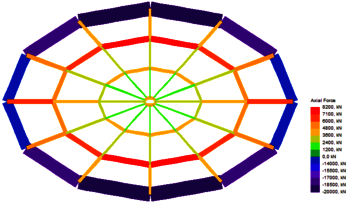Tensegrity domes
Tensegrity domes provide an efficient way of achieving a large open span. A tensegrity structure is a system based on only compression and tensile forces and it is loaded with a pretensioning force to ensure stability. The compression elements in the structure are discontinuous, and the tension members are continuous. Tensegrity domes favourably combine low structural mass with long spans. Only a few tensegrity domes are built, and it is not a widely adopted roof structure. A possible explanation for this is that the shape is most efficient when the compression hoop of the structure is based on a circular shape. A non-circular dome may be practical, but there is not much experience on how a tensegrity roof can be designed for non-circular shapes. This thesis investigates the problems that may exist in the design of circular and elliptical tensegrity domes and compression hoops, regarding the sizes of the normal forces and the bending moments, in order to find the best possible variants, and to explain why these variants perform well. The investigation is done using a variant study. A parametric design tool is made to enable the variant study. It is also investigated if it is possible to design and calculate tensegrity domes in a parametric model.
Tensegrity domes are very complex structures, which need to be designed accurately. In the variant study, many tensegrity domes must be included. The thesis therefore depends on the ability of quickly and accurately designing tensegrity domes. It is chosen to build a parametric tensegrity dome model in Grasshopper, which is a generative modelling tool for Rhinoceros 3D. The parametric model incorporates a large number of variables which determine the layout of the tensegrity dome. To eliminate input error and to speed up the analysis process, the parametric model is linked directly to Oasys GSA, which performs the structural analyses on the chosen lay-outs. To find out what constitutes a well performing tensegrity dome, a methodology is set up, based on case-studies and trials in the parametric model. A number of possible geometrical and topological variations were outlined and incorporated. Two different structural concepts, the Geiger tensegrity dome principle (see Figure 1) and the Fuller tensegrity dome principle (see Figure 2) are included. The mass of the tensegrity dome, as well as the needed amount of pretension decide the viability of the design. Different symmetrical and non-symmetrical load combinations were set up to determine the normative axial forces in the elements and nodal displacements.
Circular tensegrity domes are first considered without the compression hoop. It is found that the stiffness of a tensegrity dome is largely influenced by the geometry of the dome, which is defined by the lengths of the struts, as well as the angles and span lengths of the top cables. The mass is barely influenced by the topology, but the structural principle can be changed from a Geiger dome to a Fuller dome to increase stiffness. An elliptical tensegrity dome is found to be viable, but a circular tensegrity dome with an identical surface area performs better. The distribution of axial forces in the tensegrity is non-uniform in an elliptical tensegrity dome (see Figure 3).
Inclusion of the compression hoop adds a high amount of mass to the total structure. The mass of the compression hoop is determined by the pretension force needed for the tensegrity. Elliptical compression hoops are possible, but the distribution of normal force is non-uniform (also seen in Figure 3).
The project goals are achieved. Using parametric modelling proved to be essential for the investigation.
Student: M.V. van Telgen
Commission: H.H. Snijder, A.P.H.W. Habraken, J. Beetz
(finalized July 2012)


